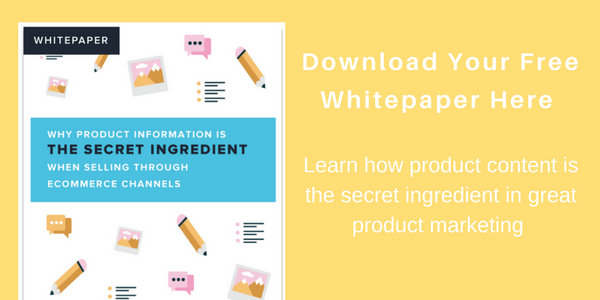.jpg)
Over the last few weeks, we’ve been engaging in conversations and learning more about product content challenges that health and beauty distributors face. This is what we found.
Each distributor, depending on their size, location, and top company priorities, had a slightly different story to tell, but we were soon able to spot some overarching trends. Here are three ecommerce challengesthat are common to this space.
Product details come in all shapes, sizes, and formats
With no manufacturing-wide standard for delivering product details to downstream partners, many health and beauty distributors find that no two relationships with suppliers are exactly alike.
Brand A delivers comprehensive Excel fact sheets in a timely manner, and new products can be added to the distributor’s inventory in a matter of minutes. Brand B, on the other hand, loosely translates their product details from another language and sends over a text file full of grammatical errors and questionable terms. And Brand C tells the distributor to simply copy down the information they’ve put up on their own brand website.
With product information pouring in from all levels of comprehensiveness and contained in all sorts of file formats, manually entering all of this data is exhausting.
A stressed data entry employee at a small distribution company in Delaware snapped at me over the phone, saying that she manually inputs new product content into computers and hounds suppliers for information all day, and thus had no time to explain the process.
The interaction was telling in and of itself – the labor-intensive procedure of standardizing all this incoming product content had this poor employee at the end of her rope.
It’s difficult to access and manipulate product information for different purposes
These days, distributors are increasingly blending traditional print catalogues with SEO-optimized e-commerce platforms, blog posts, and social media initiatives – and each purpose requires that information is presented in a slightly different way. Even if a company has a content-rich e-commerce site, the data is not stored in a way that makes it possible to easily translate that information into a catalogue, for example. Without information stored in one place, employees must parse through hundreds of data sources every time they tackle a new project.
One employee I spoke with said that the distribution company she works for expresses product details to customers in one of two ways: through articles about new product launches on their Wordpress site, or through the monthly catalogue. The employee combs through new fact sheets and data sources when the company receives a new product, and looks to see whether a product is worth writing an entire article about.
When it comes time to compile the monthly catalogue, she must comb through all of these data sources AGAIN – in all of their varied file formats and containers – to determine which products to include in the publication. She must also manually resize product photos to fit each of these purposes.
It’s important for companies to be able to easily access and manipulate their product data, especially if they’re looking to engage in new initiatives that require presenting that data in different formats.
There’s a need for a software solution, but it sounds too scary to implement
Most of the distributors I’ve talked to agree: it’s in their best interest to invest in some kind of software solution to make their processes more efficient. But how companies perceive their collective technical aptitude greatly influences how they respond to terms like “product experience management system” – and smaller companies especially don’t tend to respond to it very well.
A nail supply distributor in Los Angeles told me that she’d love to invest in software to keep better tabs of her inventory (currently maintained by simply “looking at” their supplies), but with so many older employees – and one sales lady befuddled as it is by the scanning cash register – she’s resigned herself to work with her resources. If simply researching software solutions involves having to decode big technical terms, the thought of actually implementing the software in that business environment is terrifying.
Another distributor I spoke to told me that she understands the irony in waiting until after the busy holiday season to implement a more efficient system. She says she’s still more comfortable with the thought of manually cataloguing data for an influx of holiday products than adding a new software system to the mix, but agrees that the sooner she adopts such a solution, the more efficiently and rapidly she’ll be able to expand her inventory.
Does all this sound familiar?
No matter how big a health and beauty distributor is, where it’s located, or what it’s major goals are, we’re increasingly learning that there are common product experience management issues among them, whether they’re currently dealing with them now or anticipating them further down the road. If you’re facing similar problems or are struggling with unique problems of your own, I’d love to talk through them with you: emsaka@salsify.com.
Written by: Emily Saka
Recent Posts
Omnichannel Strategy: Here Are the Top 3 Drivers of Omnichannel Profitability
Digital-Influenced Retail Will Describe 70% of U.S. Sales by 2027 — What Does This Mean for Brands?
How Frequently Do Retailer Requirements Change — and How Can Brands Keep Up?
Subscribe to the Below the Fold Newsletter
Standing out on the digital shelf starts with access to the latest industry content. Subscribe to Below the Fold, our monthly content newsletter, and join other commerce leaders.



